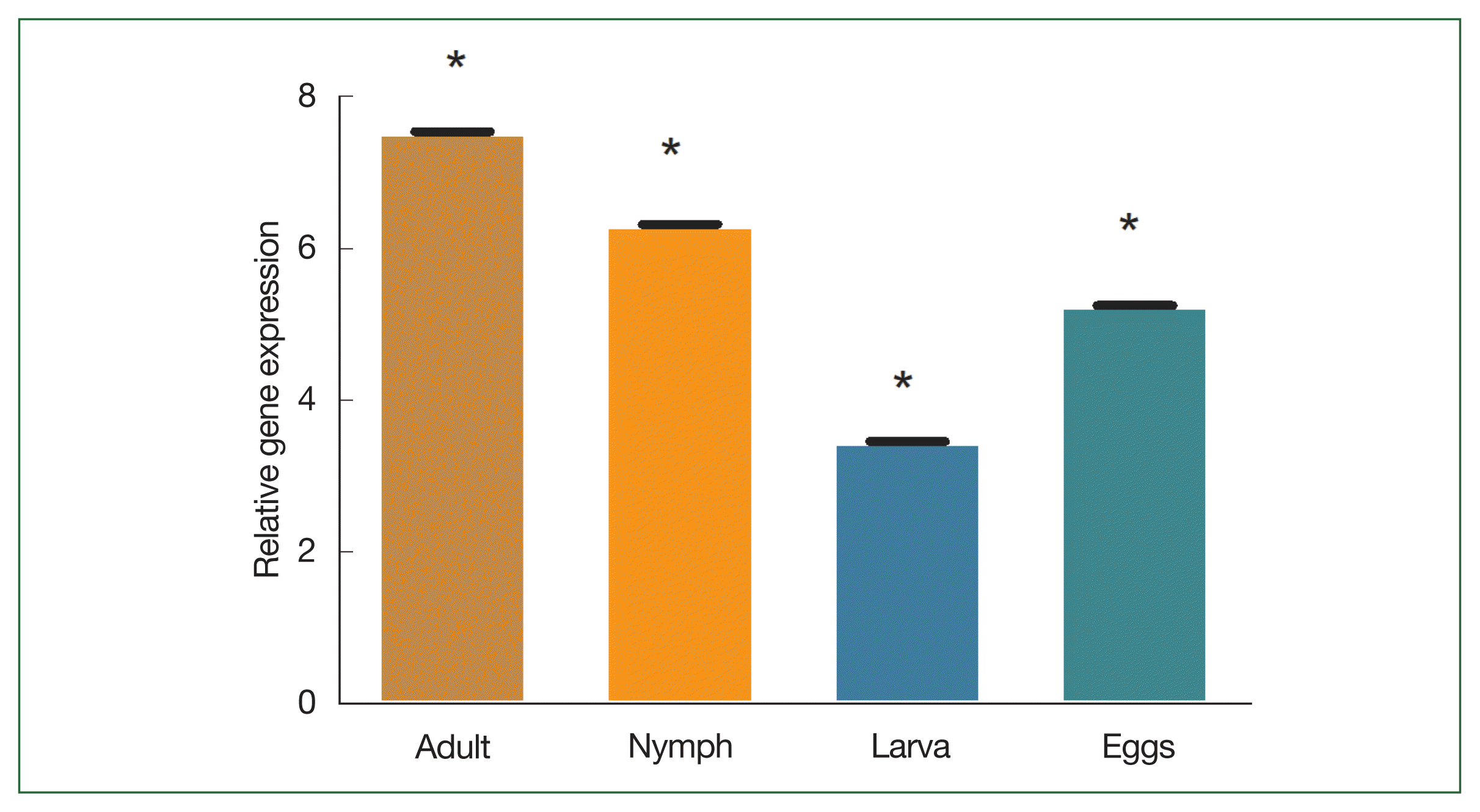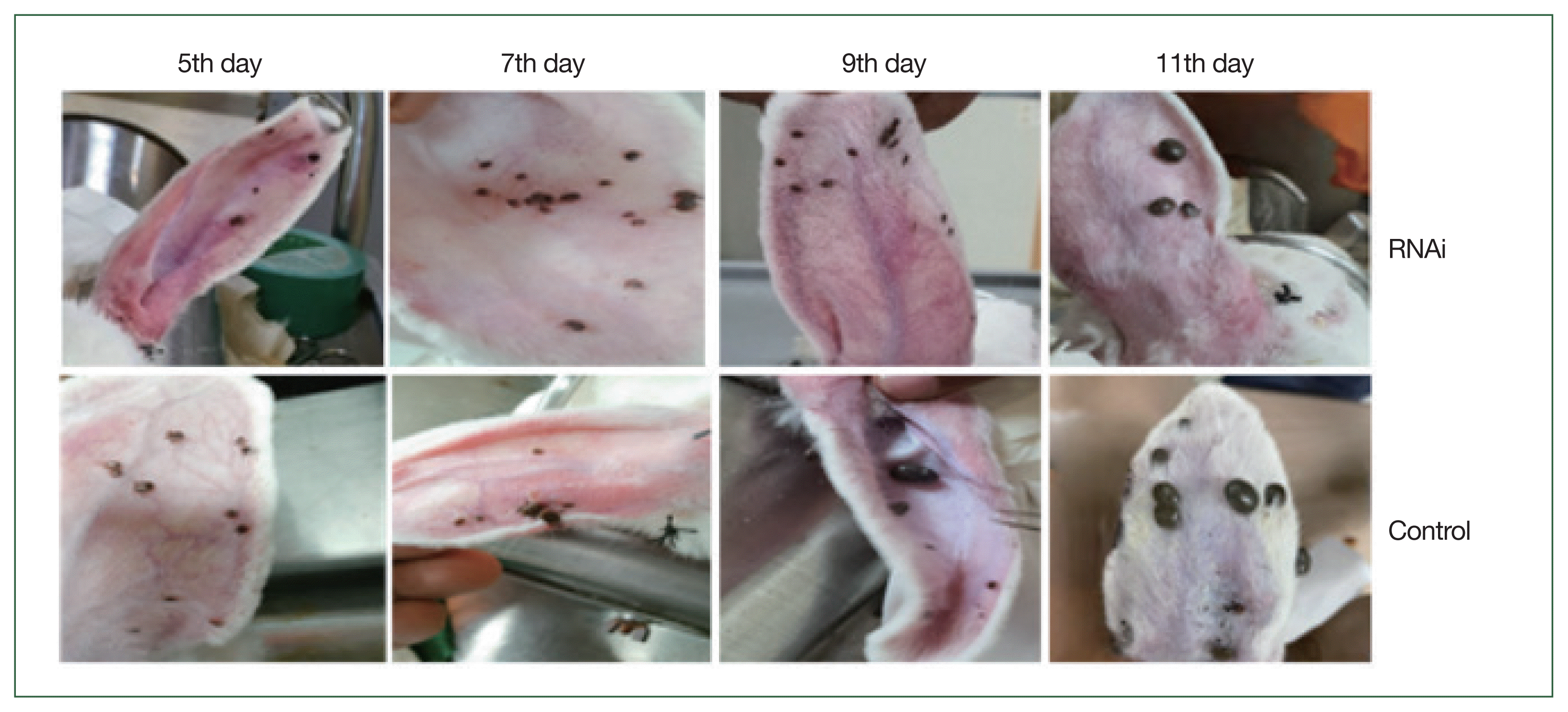1. Chae JB, Cho YS, Cho YK, Kang JG, Shin NS, et al. Epidemiological investigation of tick species from near domestic animal farms and cattle, goat, and wild boar in Korea.
Parasites Hosts Dis 2019;57(3):319-324
https://doi.org/10.3347/kjp.2019.57.3.319

2. Abbas RZ, Zaman MA, Colwell DD, Gilleard J, Iqbal Z. Acaricide resistance in cattle ticks and approaches to its management: the state of play.
Vet Parasitol 2014;203(1–2):6-20
https://doi.org/10.1016/j.vetpar.2014.03.006


3. Tirloni L, Islam MS, Kim TK, Diedrich JK, Yates JR, et al. Saliva from nymph and adult females of
Haemaphysalis longicornis: a proteomic study.
Parasit Vectors 2015;8(1):338
https://doi.org/10.1186/s13071-015-0918-y



4. Díaz-Martín V, Manzano-Román R, Oleaga A, Encinas-Grandes A, Pérez-Sánchez R. Cloning and characterization of a plasminogen-binding enolase from the saliva of the argasid tick
Ornithodoros moubata.
Vet Parasitol 2013;191(3–4):301-314
https://doi.org/10.1016/j.vetpar.2012.09.019


5. Wang WX, Li KL, Chen Y, Lai FX, Fu Q. Identification and function analysis of enolase gene NlEno1 from
Nilaparvata lugens (Stål) (Hemiptera:Delphacidae).
J Insect Sci 2015;15(1):66
https://doi.org/10.1093/jisesa/iev046



6. Xu XL, Cheng TY, Yang H. Enolase, a plasminogen receptor isolated from salivary gland transcriptome of the ixodid tick
Haemaphysalis flava.
Parasitol Res 2016;115(5):1955-1964
https://doi.org/10.1007/s00436-016-4938-0


7. Fire A, Xu S, Montgomery MK, Kostas SA, Driver SE, Mello CC. Potent and specific genetic interference by double-stranded RNA in
Caenorhabditis elegans.
Nature 1998;391(6669):806-811
https://doi.org/10.1038/35888


8. Rahman MK, Kim B, You M. Molecular cloning, expression and impact of ribosomal protein S-27 silencing in
Haemaphysalis longicornis (Acari: Ixodidae).
Exp Parasitol 2020;209:107829
https://doi.org/10.1016/j.exppara.2019.107829


9. Díaz-Martín V, Manzano-Román R, Oleaga A, Encinas-Grandes A, Pérez-Sánchez R. Cloning and characterization of a plasminogen-binding enolase from the saliva of the argasid tick
Ornithodoros moubata.
Vet Parasitol 2013;191(3–4):301-314
https://doi.org/10.1016/j.vetpar.2012.09.019


10. Di Tommaso P, Moretti S, Xenarios I, Orobitg M, Montanyola A, et al. T-Coffee: a web server for the multiple sequence alignment of protein and RNA sequences using structural information and homology extension.
Nucleic Acids Res 2011;39(suppl):W13-W7
https://doi.org/10.1093/nar/gkr245



11. Sievers F, Wilm A, Dineen D, Gibson TJ, Karplus K, et al. Fast, scalable generation of high-quality protein multiple sequence alignments using Clustal Omega.
Mol Syst Biol 2011;7:539
https://doi.org/10.1038/msb.2011.75



12. Kumar S, Stecher G, Li M, Knyaz C, Tamura K. MEGA X: molecular evolutionary genetics analysis across computing platforms.
Mol Biol Evol 2018;35(6):1547-1549
https://doi.org/10.1093/molbev/msy096



13. Rahman MK, Saiful Islam M, You M. Impact of subolesin and cystatin knockdown by RNA interference in adult female
Haemaphysalis longicornis (Acari: Ixodidae) on blood engorgement and reproduction.
Insects 2018;9(2):39
https://doi.org/10.3390/insects9020039



15. Karim S, Miller NJ, Valenzuela J, Sauer JR, Mather TN. RNAi-mediated gene silencing to assess the role of synaptobrevin and cystatin in tick blood feeding.
Biochem Biophys Res Commun 2005;334(4):1336-1342
https://doi.org/10.1016/j.bbrc.2005.07.036


16. de la Fuente J, Almazán C, Blouin EF, Naranjo V, Kocan KM. Reduction of tick infections with
Anaplasma marginale and
A. phagocytophilum by targeting the tick protective antigen subolesin.
Parasitol Res 2006;100(1):85-91
https://doi.org/10.1007/s00436-006-0244-6


17. Commins SP, James HR, Kelly LA, Pochan SL, Workman LJ, et al. The relevance of tick bites to the production of IgE antibodies to the mammalian oligosaccharide galactose-α-1, 3-galactose.
J Allergy Clin Immunol Pract 2011;127(5):1286-1293. e6
https://doi.org/10.1016/j.jaci.2011.02.019

18. Kocan KM, Manzano-Roman R, de la Fuente J. Transovarial silencing of the subolesin gene in three-host ixodid tick species after injection of replete females with subolesin dsRNA.
Parasitol Res 2007;100(6):1411-1415
https://doi.org/10.1007/s00436-007-0483-1


19. Rahman MK, You M. Molecular cloning and transcriptional and functional analysis of glycogen synthase kinase-3β in Haemaphysalis longicornis (Acari, Ixodidae).
Parasite 2019;26:39
https://doi.org/10.1051/parasite/2019038



22. Sigrist CJA, De Castro E, Cerutti L, Cuche BA, Hulo N, et al. New and continuing developments at PROSITE.
Nucleic Acids Res 2012;41(database issue):344-347
https://doi.org/10.1093/nar/gks1067

23. Cao H, Zhou Y, Chang Y, Zhang X, Li C, et al. Comparative phosphoproteomic analysis of developing maize seeds suggests a pivotal role for enolase in promoting starch synthesis.
Plant Sci 2019;289:110243
https://doi.org/10.1016/j.plantsci.2019.110243


24. Quintero-Troconis E, Buelvas N, Carrasco-López C, Domingo-Sananes M, González-González L, et al. Enolase from
Trypanosoma cruzi is inhibited by its interaction with metallocarboxypeptidase-1 and a putative acireductone dioxygenase.
Biochim Biophys Acta Proteins Proteom 2018;1866(5–6):651-660
https://doi.org/10.1016/j.bbapap.2018.03.003


26. Neelakanta G, Sultana H. Tick saliva and salivary glands: what do we know so far on their role in arthropod blood feeding and pathogen transmission.
Front Cell Infect Microbiol 2022;11:816547
https://doi.org/10.3389/fcimb.2021.816547



27. Xu XL, Cheng TY, Yang H. Enolase, a plasminogen receptor isolated from salivary gland transcriptome of the ixodid tick
Haemaphysalis flava.
Parasitol Res 2016;115(5):1955-1964
https://doi.org/10.1007/s00436-016-4938-0


28. Avilán L, Gualdrón-López M, Quiñones W, González-González L, Hannaert V, et al. Enolase: a key player in the metabolism and a probable virulence factor of trypanosomatid parasites-perspectives for its use as a therapeutic target.
Enzyme Res 2011;2011:932549
https://doi.org/10.4061/2011/932549



29. Piast M, Kustrzeba-Wójcicka I, Matusiewicz M, Banaś T. Molecular evolution of enolase.
Acta Biochim Pol 2005;52(2):507-513.


31. de la Torre-Escudero E, Manzano-Román R, Pérez-Sánchez R, Siles-Lucas M, Oleaga A. Cloning and characterization of a plasminogen-binding surface-associated enolase from
Schistosoma bovis.
Vet Parasitol 2010;173(1–2):76-84
https://doi.org/10.1016/j.vetpar.2010.06.011

32. Díaz-Ramos À, Roig-Borrellas A, García-Melero A, López-Alemany R. α-Enolase, a multifunctional protein: its role on pathophysiological situations.
J Biomed Biotechnol 2012;2012
https://doi.org/10.1155/2012/156795

33. Imamura S, Junior IdSV, Sugino M, Ohashi K, Onuma M. A serine protease inhibitor (serpin) from
Haemaphysalis longicornis as an anti-tick vaccine.
Vaccine 2005;23(10):1301-1311
https://doi.org/10.1016/j.vaccine.2004.08.041


34. Ren S, Zhang B, Xue X, Wang X, Zhao H, et al. Salivary gland proteome analysis of developing adult female
Haemaphysalis longicornis ticks: molecular motor and TCA cycle-related proteins play an important role throughout development.
Parasit Vectors 2019;12(1):1-16
https://doi.org/10.1186/s13071-019-3864-2


36. Xu XL, Cheng TY, Yang H, Yan F, Yang Y. De novo sequencing, assembly and analysis of salivary gland transcriptome of
Haemaphysalis flava and identification of sialoprotein genes.
Infect Genet Evol 2015;32:135-142
https://doi.org/10.1016/j.meegid.2015.03.010










